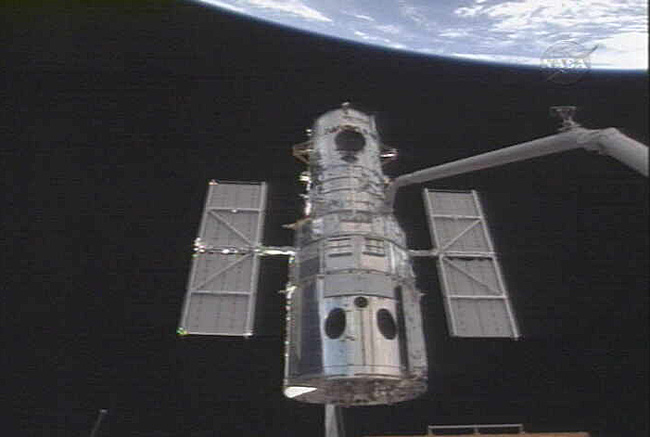Chinese Space Junk Buzzes Shuttle, Hubble Telescope

This story was updated at 8:04 p.m. EDT
HOUSTON — NASA on Wednesday tracked a piece of space junk leftover from a Chinese anti-satellite test in 2007 that zoomed past the shuttle Atlantis and the attached Hubble Space Telescope, which astronauts plucked from orbit earlier in the day.
The satellite debris flew about 1.7 miles (2.8 km) ahead and a bit below Atlantis at its closest approach, but it was well clear of the shuttle and did not require the astronaut crew to move the spacecraft.
"No action was required for the crew," said NASA commentator Pat Ryan on NASA TV.
Ryan said the piece of debris was small, about 4 inches (10 cm) in size. It buzzed by Atlantis at about 7:28 p.m. EDT (2328 GMT). In addition to flying in front of Atlantis, the space junk was about 492 feet (150 meters) below and just over 2.4 miles (4 km) outside the shuttle's orbital plane, Ryan said.
Atlantis and Hubble are currently flying about 350 miles (653 km) above Earth in an orbit that has a higher risk of space debris hits, in part because of the Chinese anti-satellite test, in which China intentionally destroyed the weather satellite Fengyun 1C in 2007.
An accidental crash between a Russian and U.S. satellite that occurred on Feb. 10 as both were flying 490 miles (790 km) above Siberia also contributed to the extra risk, NASA officials have said.
Breaking space news, the latest updates on rocket launches, skywatching events and more!
NASA typically moves spacecraft clear of space junk that wanders too near a shuttle or the International Space Station when the debris passes within a box-like boundary around the crewed vehicle. The Chinese debris was in NASA's "yellow" category, meaning a maneuver to dodge would be unlikely, agency officials said in a statement.
Space junk risk
The risk of a piece of space junk seriously damaging Atlantis is about a 1-in-229 chance in its current orbit. That is higher than the typical 1-in-300 chance of major hits for shuttles headed to the International Space Station, which flies in a lower 220-mile (354-km) orbit, but is within NASA's flight rule limits, the agency has said.
LeRoy Cain, NASA's deputy shuttle program manager, told reporters Wednesday that NASA and the Department of Defense's U.S. Space Surveillance Network are tracking the debris environment around Atlantis and Hubble much the same as they would for any manned spaceflight.
"We're not doing anything different," Cain said in a briefing here at NASA's Johnson Space Center. "The process is a good one. It's tried and true."
In the extremely remote chance that the Atlantis suffers a serious strike and cannot return to Earth, NASA has also primed the shuttle Endeavour to launch a rescue mission to retrieve the stranded astronauts.
Healthy heat shield
The Atlantis astronauts are flying an 11-day mission to Hubble to perform NASA's fifth and final service call on the aging space telescope. Earlier Wednesday, they used the shuttle's robotic arm to grab Hubble and secure it in their cargo bay so it can be upgraded and repaired.
On Thursday, they will begin the first of five back-to-back spacewalks to install two new cameras, attempt unprecedented repairs on two other instruments and perform some much-needed maintenance.
Cain said today that Atlantis' heat shield appears to be in fine shape based on the analysis of a detailed inspection performed by the shuttle crew yesterday. An impact sensor on one of the heat-resistant panels lining the shuttle's starboard wing did detect an apparent debris strike within the last 24 hours, but the hit was too weak to cause any serious damage, Cain said.
Mission Control radioed the Atlantis astronauts late Wednesday to say that no focused inspection of their heat shield with a sensor-tipped boom will be required tomorrow. A trail of minor dings to some starboard side tiles were already deemed to pose no health concern for Atlantis, NASA said.
"That's excellent news," Atlantis skipper Scott Altman said. "We appreciate that."
Flight controllers did ask the astronauts to pencil in some time on Friday for a quick robotic arm scan of 16 heat-resistant tiles near the shuttle's nose. The tiles were inadvertently skipped during an inspection earlier this week.
NASA has kept a close eye on the integrity of its shuttle heat shields during flight since 2003, when a piece of launch debris damaged the shuttle Columbia's heat shield, ultimately leading to its destruction and the deaths of seven astronauts during re-entry.
SPACE.com is providing continuous coverage of NASA's last mission to the Hubble Space Telescope with senior editor Tariq Malik in Houston and reporter Clara Moskowitz in New York. Click here for mission updates and SPACE.com's live NASA TV video feed.

Tariq is the award-winning Editor-in-Chief of Space.com and joined the team in 2001. He covers human spaceflight, as well as skywatching and entertainment. He became Space.com's Editor-in-Chief in 2019. Before joining Space.com, Tariq was a staff reporter for The Los Angeles Times covering education and city beats in La Habra, Fullerton and Huntington Beach. He's a recipient of the 2022 Harry Kolcum Award for excellence in space reporting and the 2025 Space Pioneer Award from the National Space Society. He is an Eagle Scout and Space Camp alum with journalism degrees from the USC and NYU. You can find Tariq at Space.com and as the co-host to the This Week In Space podcast on the TWiT network. To see his latest project, you can follow Tariq on Twitter @tariqjmalik.
